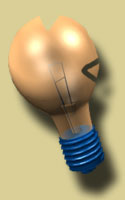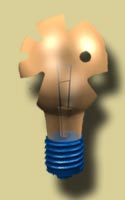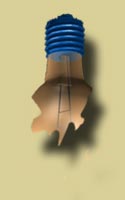![]()
plasma 7
|
|
|
p l a s m a 7 |
|
 |
Die Zahl 7 |
 |
Plasma in der Physik
Plasma (physics), in physics, usually gaseous state of matter in which a part or all of the atoms or molecules are dissociated to form ions (see IONIZATION). Plasmas consist of a mixture of neutral particles, positive ions (atoms or molecules that have lost one or more electrons), and negative electrons. A plasma is a conductor of electricity, but a volume with dimensions greater than the so-called Debye length exhibits electrically neutral behavior. At a microscopic level, corresponding to distances shorter than the Debye length, the particles of a plasma do not exhibit collective behavior but instead react individually to a disturbance, for example, an electric field. On the earth, plasmas usually do not occur naturally except in the form of lightning bolts, which consist of narrow paths of air molecules of which approximately 20 percent are ionized, and in parts of flames. The free electrons in a metal can also be considered as a plasma. Most of the universe, however, consists of matter in the plasma state. The ionization is caused either by high temperatures, such as inside the sun and stars, or by radiation, such as the ionization of interstellar gases or, closer to the earth, the upper layers of the atmosphere (see IONOSPHERE), producing the aurora. Plasmas can be created by applying an electric field to a low-pressure gas, as in neon or fluorescent tubes (see NEON LAMP). A plasma can also be created by heating a neutral gas to very high temperatures. Usually the required temperatures are too high to be applied externally, and the gas is heated internally by the injection of high-speed ions or electrons that collide with the gas particles, increasing their thermal energy. The electrons in the gas can also be accelerated by external electric fields. Ions from such plasmas are used in the semiconductor industry for etching surfaces and otherwise altering the properties of materials. In very hot plasmas the particles acquire enough energy to engage in nuclear reactions with each other during collisions. Such fusion reactions are the heat source in the sun's core, and scientists are trying to create artificial plasmas in the laboratory in which fusion reactions would produce energy for the production of electricity.
See also FUSION; NUCLEAR ENERGY; PHYSICS: DEVELOPMENTS IN PHYSICS SINCE 1930: PLASMA PHYSICS. |
|
|
Plasma in der Biologie
Blood is composed of a yellowish fluid, called plasma, in which are suspended the millions of cells that constitute about 45 percent by volume of whole blood. It has a characteristic odor and a specific gravity between 1.056 and 1.066. In an average healthy adult, the volume of blood is one-eleventh of the body weight, or between 4.5 and 6 liters (5 and 6 qt). A great portion of the plasma is composed of water, a medium that facilitates the circulation of the many indispensable factors of which blood is composed. A cubic millimeter of human blood contains about 5 million red corpuscles called erythrocytes; 5000 to 10,000 white corpuscles called leukocytes; and 200,000 to 300,000 platelets called thrombocytes. The blood also carries many salts and organic substances in solution. Plasma is a complex substance; its principal component is water. It also contains plasma proteins; such inorganic constituents as sodium, potassium, calcium chloride, carbonate, and bicarbonate; sugar; hormones; enzymes; fats; amino acids; and such waste products as urea and creatinine. All these substances occur in minute quantities. Among the component plasma proteins are albumin, the principal agent in maintaining the osmotic pressure of the blood and therefore in controlling its tendency to diffuse through the walls of blood vessels; a dozen or more proteins, including fibrinogen and prothrombin, which participate in clotting; agglutinins, which cause the agglutination reaction between samples of blood of different types and the reaction known as anaphylaxis, a form of allergic shock; and globulins of many types, which include the antibodies (see ANTIBODY) that provide immunity against many diseases. Other significant plasma proteins function as carriers of such essential tissue nutrients as copper, iron, other metals, and a variety of hormones. Separation of plasma proteins for individual study was first accomplished in the 1920s; large- scale fractionation, allowing use of the individual fractions, was accomplished during World War II by the American biochemist Edwin Joseph Cohn and his associates. Some of the results of this work include the use of serum albumin as a substitute for blood or plasma for transfusion; the use of gamma globulin for short-term protection against such diseases as measles and hepatitis; and the use of antihemophilic globulin for the treatment of hemophilia.
|
|
© 2003 by Ihr Osiris • plasma7@freenet.de Diese Seite ist Teil eines Framesets [this page is part of a frameset] LOAD FRAMESET |
|
